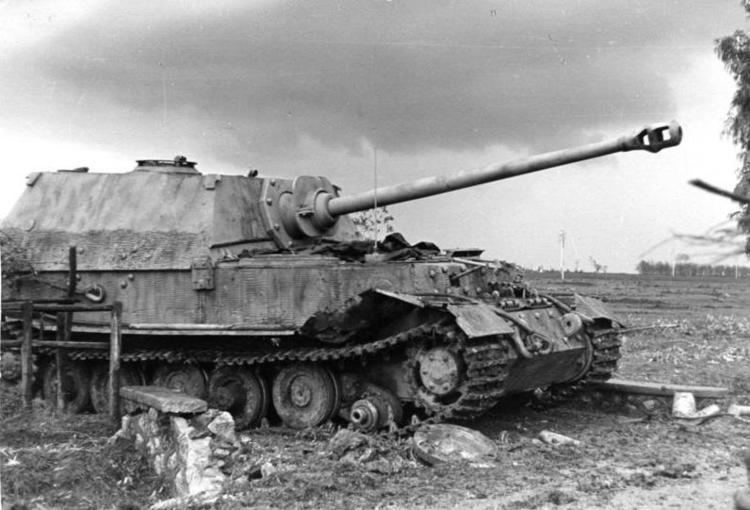 | ||
The 653rd Heavy Panzerjäger Battalion (Schwere Panzerjäger-Abteilung 653.) was a tank destroyer unit of the Wehrmacht active during World War II. It was equipped with Ferdinand and later Jagdtiger tank destroyers. Elements of the battalion served on the Eastern, Western, and Italian fronts between 1943 and 1945.
Contents
Soviet Union and Italy
The battalion was formed on 31 March 1943, by the redesignation of the 197th Sturmgeschütz Battalion. The 197th was an assault gun battalion which had been formed in 1940, later seeing service during the Invasion of Yugoslavia and on the Eastern Front. The 653rd was initially equipped with Ferdinand tank destroyers; the Ferdinand was a heavy tank destroyer built on chassis originally intended for the VK4501 variant of the Tiger I, mounting a powerful 88 mm gun.
It was assigned to the XXXXI Panzer Corps, and fought at the Battle of Kursk in August, and around Nikopol during the Battle of the Dnieper. After heavy losses in Ukraine, the battalion was withdrawn to Vienna to refit. The 1st Company received 11 new Elefants - the new name for the added defensive hull-machine gun mount armed version of the Ferdinand - and was sent south to Italy where it fought at the Battle of Anzio in February 1944. The 2nd and 3rd companies were equipped with 30 new vehicles in April and sent to the Eastern Front, where they were attached to the XXIV Panzer Corps.
By August, the 2nd and 3rd were reduced to twelve vehicles between them; these were withdrawn to refit in Kraków, where they were combined into the 2nd Company. It remained on the Eastern Front, as part of 17th Army, and was redesignated the 614th Heavy Panzerjäger Company. It would see out the rest of the war fighting the Soviet Army, with two Elefants surviving until the Battle of Berlin in May 1945.
Western Front
The 3rd Company, meanwhile, returned west to rejoin the 1st Company, which had withdrawn to Vienna with only four operational Elefants. In September, both were re-equipped with Jagdtiger heavy tank destroyers. The Jagdtiger was the heaviest armoured fighting vehicle produced during the war, mounting a 128 mm main gun inside a 72-tonne chassis. However, it was severely underpowered, mounting an engine originally designed for the 57-tonne Tiger I, and which had already been found inadequate even for that vehicle. It was only produced in very small numbers - around 80 were built - and would only be issued to two units; the 653rd and the 512th Heavy Panzerjäger Battalion.
Once reequipped, the battalion was again split up, with the 1st Company assigned to the 15th Army on the northern flank of the Ardennes Offensive, and the 3rd assigned to the 17th SS Panzergrenadier Division Götz von Berlichingen to the south, where it would fight in Operation Nordwind in January. By February, the two companies had reunited at Landau in the Palatinate; at the end of the month, they were reinforced to a strength of 41 Jagdtigers. In April it fell back to Austria, where it was to receive new vehicles from the Nibelungenwerk factory, and ended the war under the command of Army Group Ostmark near Linz.
